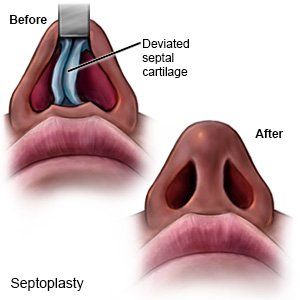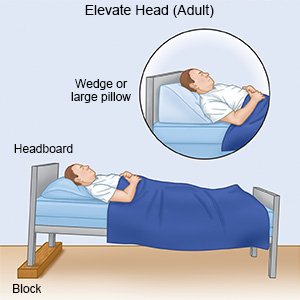After Septoplasty
Medically reviewed by Drugs.com. Last updated on Aug 4, 2025.
AMBULATORY CARE:
What you need to know about septoplasty:
Septoplasty is surgery to repair or straighten your nasal septum. The nasal septum is the cartilage and bone that forms a wall to separate your nostrils. Septoplasty may relieve symptoms such as trouble breathing, dry mouth, or frequent nasal congestion. Septoplasty is most commonly done in adults but may also be done in children.
 |
How to prepare for septoplasty:
- Your surgeon will talk to you about how to prepare for surgery. You may be told not to eat or drink anything after midnight on the day of your surgery. Arrange to have someone drive you home when you are discharged.
- Tell your surgeon about all your current medicines. Your surgeon will tell you if you need to stop any medicine for surgery, and when to stop. Your surgeon will tell you which medicines to take or not take on the day of your surgery.
- Tell your surgeon about any allergies you have, including to anesthesia or medicines. You may be given an antibiotic to help prevent a bacterial infection.
- Your surgeon will tell you if you need any tests before your surgery, and when to have them.
What will happen during septoplasty:
- You may receive general anesthesia to keep you asleep and pain free during surgery. You may instead receive local anesthesia to numb the surgery area. With local anesthesia, you may still feel pressure or pushing during surgery, but you should not feel any pain.
- Your surgeon will cut and reattach your septum to straighten it. Swollen tissues may also be trimmed or partially removed. You may have small splints on either side of your septum to hold it in place. Or, you may have stitches that dissolve. You may have gauze or a soft splint inside your nose to help prevent bleeding.
What will happen after septoplasty:
You may have pain, nasal stuffiness, and feel tired or lethargic after surgery. The nasal stuffiness is caused by swelling in your nose, and will decrease in about 1 week. You may also have mild drainage of mucus and blood.
Risks of septoplasty:
You may bleed more than expected or get an infection. Your symptoms may not go away. The shape of your nose, your voice, or your sense of taste or smell may change. You may have swelling or bruising around your eye. You may have numbness in your nose, upper teeth, or gums. Blood may build up on your septum, or it may tear. The fluid around your brain may drain from your nose.
Related medications
Call your local emergency number (911 in the US), or have someone call if:
- You have trouble breathing.
Seek care immediately if:
- Clear fluid comes out of your nose when you bend your head forward.
- Your heart is beating fast or has an irregular rhythm.
- Your nose or the roof of your mouth is pale or starting to turn black.
- You have severe pain.
- You have red streaks on the skin around your nose.
Call your surgeon if:
- Your symptoms do not improve within 1 week.
- Your nose bleeds more than you were told to expect.
- You have a fever.
- Your nose is red, swollen, and draining pus.
- Your upper teeth, gum, or nose is numb.
- You have a change in your vision.
- You have questions or concerns about your condition or care.
Medicines:
You may need any of the following:
- Nasal sprays may be prescribed to help decrease swelling and congestion.
- Antibiotics help treat or prevent an infection caused by bacteria.
- Prescription pain medicine may be given. Ask your healthcare provider how to take this medicine safely. Some prescription pain medicines contain acetaminophen. Do not take other medicines that contain acetaminophen without talking to your healthcare provider. Too much acetaminophen may cause liver damage. Prescription pain medicine may cause constipation. Ask your healthcare provider how to prevent or treat constipation.
- NSAIDs , such as ibuprofen, help decrease swelling, pain, and fever. This medicine is available with or without a doctor's order. NSAIDs can cause stomach bleeding or kidney problems in certain people. If you take blood thinner medicine, always ask your healthcare provider if NSAIDs are safe for you. Always read the medicine label and follow directions.
- Take your medicine as directed. Contact your healthcare provider if you think your medicine is not helping or if you have side effects. Tell your provider if you are allergic to any medicine. Keep a list of the medicines, vitamins, and herbs you take. Include the amounts, and when and why you take them. Bring the list or the pill bottles to follow-up visits. Carry your medicine list with you in case of an emergency.
Self-care:
- Do not blow your nose. The increase in pressure can cause your nose to bruise, swell, or bleed. Try not to sneeze. If you have to sneeze, keep your mouth open to decrease pressure in your nose.
- Elevate your head and upper back. Place extra pillows under your head, neck, and shoulders when you sleep in bed. Try not to bend your neck. Elevation will help decrease swelling.

- Apply ice. Do this for 15 to 20 minutes every hour for the first day. Use an ice pack, or put crushed ice in a plastic bag. Cover the bag with a towel before you apply it on your nose. Ice helps prevent tissue damage and decreases swelling and pain.
- Use a cool mist humidifier. A cool mist humidifier will increase air moisture in your home. This will help keep your nose and throat moist and prevent irritation.
- Limit activity for 3 days or as directed. Ask when you can return to your usual daily activities.
- Care for your surgery area as directed. You may be able to use saltwater or hydrogen peroxide to remove crusts. If you have a splint, do not get it wet or try to remove it.
- Do not smoke. Nicotine and other chemicals in cigarettes and cigars can irritate your nose and delay healing. Ask your healthcare provider for information if you currently smoke and need help to quit. E-cigarettes or smokeless tobacco still contain nicotine. Talk to your healthcare provider before you use these products.
Follow up with your surgeon as directed:
You may need to return to have your gauze or splint removed. Write down your questions so you remember to ask them during your visits.
© Copyright Merative 2025 Information is for End User's use only and may not be sold, redistributed or otherwise used for commercial purposes.
The above information is an educational aid only. It is not intended as medical advice for individual conditions or treatments. Talk to your doctor, nurse or pharmacist before following any medical regimen to see if it is safe and effective for you.
Further information
Always consult your healthcare provider to ensure the information displayed on this page applies to your personal circumstances.
